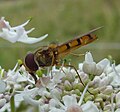Lauster quarry (Schopfloch)
The former Lauster quarry in the "Ulrichshalde" district north of Schopfloch is now part of a nature conservation center as a biotope and geotope . Since 1997 it has been designated as an extensive natural monument under the name of Steinbruch im Gewann Obere Ulrichshalde .
history
Originally, the Karl Hoyler company from Ochsenwang began mining rocks near Schopfloch in 1929 to produce gravel for road construction. After Hoyler soon stopped work in the quarry, the Lauster company from Bad Cannstatt took over the site in 1949 . Until 1974, Lauster mined Jura marble from the White Jura epsilon in the mine . Blocks of stone, sometimes more than two cubic meters, were broken with bores and wedges and then brought to the main factory of the Lauster company, where they were processed into panels for interior construction, e.g. for stairs, tiles and window sills. Since the "Schopflocher marble" is not frost-resistant, the use of the yellow-gray limestone was limited to these areas.
In 1974 Lauster gave up the quarry. A habitat for plants and animals developed on the three-hectare site, so that in 1985, when the owner at the time wanted the Landratsamt Esslingen to approve the filling and recultivation of the quarry, these plans were rejected. In 1986 the Esslingen district took over the site from the Moeck company in order to set up a nature conservation center on and next to the quarry site . This was opened in 1989 and has been supported jointly by the state of Baden-Württemberg and the district since 1995. Every year it offers around 300 events, including guided tours of the former Lauster quarry. The nature conservation center is currently (as of August 2010) being expanded. In the future, it will also serve as an information center in the UNESCO Swabian Alb Biosphere Reserve and as an information point in the Geopark.
Traces of work in the quarry
The old Lauster company sign was found in the quarry, restored and attached to the entrance. Furthermore, numerous drill holes and brackets for cooling water tanks can be seen in the rocks and stone blocks. A transformer station is still preserved in the quarry. The old entrance posts clad with natural stones have also been preserved.
Ecological importance
The former quarry offers not only moist and shady rock faces due to its numerous sunny plateaus, but also species that love dry and warm conditions, a habitat. This resulted in a particularly high biodiversity. In addition to lichens, mosses and ferns, plants such as the Karthauser carnation and the forest hyacinth can be found in the former quarry. Foxes, kestrels and lizards as well as numerous insects inhabit the area. To prevent overgrown trees and bushes, the area is temporarily grazed by a herd of goats.
Jurassic marble
Jura marble is a wear-resistant, abrasive and polishing capable limestone that some 150 million years ago from calcium deposits in the Jurassic sea emerged that large parts of southern Germany covered. The limestone and dolomite deposits left by this sea and its inhabitants, pebble sponges, corals and algae, were up to 400 meters thick, but have largely been eroded on the Swabian Alb . Jurassic marble is also known as marble or ivory marble because it can have a white-yellowish color due to the deposition of iron oxides . Its structure is partly cloudy like real marble.
Web links
Coordinates: 48 ° 33 ′ 2 " N , 9 ° 31 ′ 47" E





